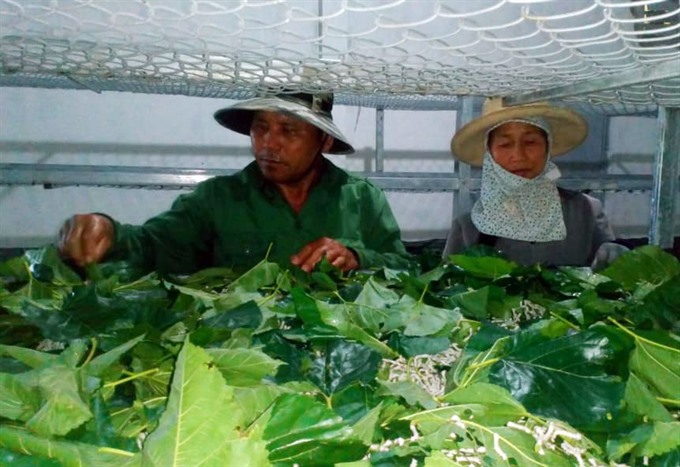 Society
Society

Sericulture has been expanding in Lâm Đồng Province, the country’s largest silk producer, as it offers farmers high incomes and gets incentives from authorities.
 |
| Farmers breed silkworms in the Tây Nguyên (Central Highlands) province of Lâm Đồng. — Photo baolamdong.vn |
LÂM ĐỒNG — Sericulture has been expanding in Lâm Đồng Province, the country’s largest silk producer, as it offers farmers high incomes and gets incentives from authorities.
In Đạ Tẻh District, thousands of households are planting mulberry trees on 1,340ha for breeding silkworms, according to the local People’s Committee.
Đinh Thị Nhiễu, chairwoman of the Đạ Pal Commune Farmers Association in Đạ Tẻh, said 99 per cent of households in the commune are growing mulberry and breeding silkworms.
Đạ Pal and Đạ Lây communes have had a tradition of planting mulberry for breeding silkworms since the 1980s.
This has now been expanded for the first time to other communes like Mỹ Đức, Quốc Oai and Đạ Kho.
Nguyễn Ngọc Thư, chairman of the Mỹ Đức Commune People’s Committee, said mulberry can be considered the optimal plant for reducing poverty in the commune.
The tree’s leaves are ready to be harvested six months after planting and requires little expenditure, he said.
With an average income of VNĐ200-250 million (US$8,600-10,700) per hectare of mulberry a year, there is no short-term crop offering higher profits than mulberry, he said.
The commune has three silkworm co-operatives with 550 households as members, or 50 per cent of the total number.
Bùi Văn Hùng, chairman of the Đạ Tẻh District People’s Committee, said the district has encouraged farmers to switch from other crops like sugarcane and cashew to mulberry if their lands are suitable for growing the plant.
The district has supported farmers with a subsidy of VNĐ5 million ($214) per hectare for switching from low-yielding crops to others.
Farmers in the district have converted 300ha of old and disease-hit cashew lands into mulberry fields this year.
The district has solicited investment in silk processing.
One investor has built a plant in Mỹ Đức Commune and is now installing machinery. The plant, which has a capacity of producing 40 tonnes of silk a day, will be able to process most of silk cocoons produced in the district.
Currently, the cocoons are sold to enterprises in the province’s Bảo Lộc City.
Lâm Hà District, the biggest silkworm producer in the province, has around 2,600ha under mulberry, according to its Agriculture and Rural Development Division.
Nguyễn Thị Hạnh, who plants mulberry and breeds silkworms in the district’s Đông Thanh Commune, said the price of cocoons has been high in recent years at VNĐ120,000-220,000 ($5.1-9.4) a kilogramme.
These prices ensure a steady income for farmers, she said.
One hectare of mulberry can supply enough leaves for breeding 80 boxes of silkworm cocoons a year.
Each box, containing 15-25 grams of silkworm eggs, which take about 24 days from hatching to producing cocoons, can produce about 50kg of cocoons.
Many farmers in Lâm Hà District have switched from rice, coffee, tea and other crops to mulberry.
The district plans to expand its area under the tree to 3,000ha and produce more than 31,000 tonnes of silk cocoons a year by 2020.
The province’s sericulture reached its peak in the 1990s but later declined due to several reasons, including failure to adopt advanced techniques to produce silk.
But it was revived in 2010 as global demand for silk surged and the province began to adopt advanced techniques.
It now has more than 5,200ha of mulberry, according to its Department of Agriculture and Rural Development.
Bảo Lộc City has many modern silk plants and accounts for 75 per cent of the country’s silk cocoon processing and 70 per cent of silk weaving, according to its Economy Division.
The province’s silk is mostly exported. — VNS




